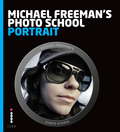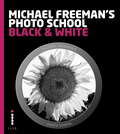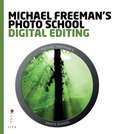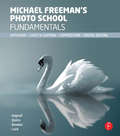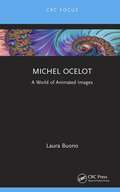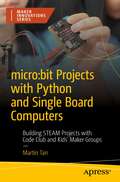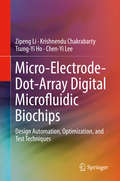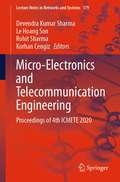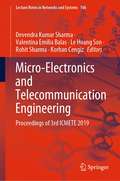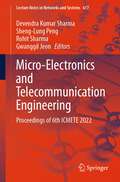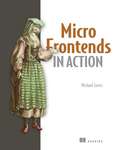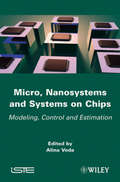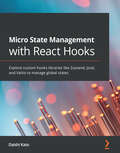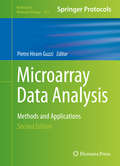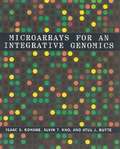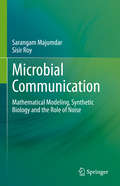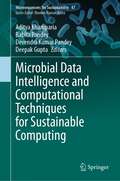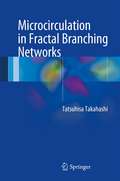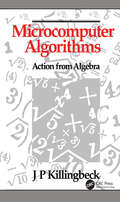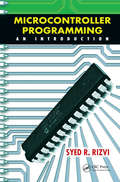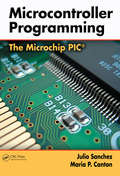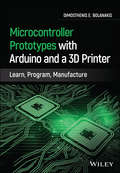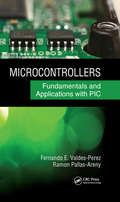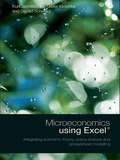- Table View
- List View
Michael Freeman's Photo School: Portrait (Michael Freeman's Photo School)
by Michael FreemanAt some point, all photographers are called upon to shoot a proper portrait - combining technical skill with personable demeanour to capture someone in their best possible light. Michael Freeman teaches you how to achieve flattering portrait results with a variety of both traditional and modern styles.Learn how to set your subjects at ease and bring out their natural beauty with a friendly yet professional attitude. Feel confident giving directions on posing and stance with a thorough review of the classic approaches, from head-and-shoulder shots to full-length compositions, and everything in between.Take creative control of your portrait sessions by learning to manipulate the light to your own ends - whether that means bouncing sunlight o a reflector or building your own studio setups with multiple fl ash units. The complex science of photographic lighting is explained in straightforward and easy-to-understand language, with abundant and inspirational examples. Finally, master the fundamentals of post-production finishing techniques to make sure every portrait looks its absolute best. Your subjects will thank you for it!
Michael Freeman's Photo School: Black And White (Michael Freeman's Photo School)
by Michael FreemanFrom timeless, elegant portraits to gritty, graphic street shots, the possibilities of black and white are endless, enticing, and exciting. Recognising this potential within every shot, and knowing the digital-editing tools and techniques to maximize its effect are essential steps to building up your photographic repertoire.Having first established the fundamental aesthetic choices that go into every B&W conversion, Michael Freeman goes on to review the noble tradition of black and white, detailing its numerous styles and fashions, with step-by-step instructions on how to achieve each effect, regardless of your particular software. Presented in a straightforward and easy-to-understand format, you will soon be able to both visualise exactly how you want your final image to appear, and achieve that signature look with efficient workflows and powerful conversion techniques.These skills open up new worlds of photographic opportunity everywhere you look, and encourage artistic growth just as much as they inspire you to try new styles and exciting treatments.
Michael Freeman's Photo School: Digital Editing: Essential Aspects Of Digital Editing (Michael Freeman's Photo School)
by Michael FreemanUnlock the full potential of each and every image with reliable post-production techniques that will become a fundamental part of your photography. Using easily followed, step-by-step instructions, Michael Freeman demystifies the complexities of today's high-powered editing programs to provide you with effective digital workflows tailored to your particular photographic style, and using whichever editing programs you are most comfortable with.Begin by exploring the fundamental aspects of image optimisation, from fixing exposure and making colour adjustments, to sharpening and noise reduction - essential steps that elevate simple snapshots to stunning images. Then move on to explore the advanced possibilities of black-and-white conversion, panoramic stitching, HDR imaging, and more. Learn to recognise the right tools for the job, saving you time on the computer and ensuring each image gets the treatment it deserves.Whether you're salvaging an underexposed shot or building a composite of multiple images, these techniques will give your photography a professional and refined style.
Michael Freeman's Photo School Fundamentals: Exposure, Light & Lighting, Composition
by Michael FreemanPhotography is international best-seller Michael Freeman’s life, and in this book he works together with fellow photography experts to share his and their knowledge with anyone who wants to learn not only how to take better photos, but also why those photographs work and where they fit in with the history of the craft. Inspired by the structure of a college course and the benefits of a collective learning environment, this book teaches the fundamentals of photography not just through comprehensive lessons and instructions, but also through challenges in which readers can participate. Sample work from Michael’s students provides inspiration, and critical evaluations of the results ensure that the core concepts are being grasped every step of the way. Additionally, readers can join in by sharing their work via the series’ dedicated website.
Michel Ocelot: A World of Animated Images
by Laura BuonoThis unique book examines the career of Michel Ocelot, from his earliest works to his latest research and productions, including an interview regarding his latest film Le Pharaon, le Sauvage et la Princesse (2022). The book highlights the director’s role in the panorama of contemporary animated cinema and his relationship with the tradition, both artistic and cinematographic. The book carefully analyses the ethical and social nature of Ocelot’s work to underscore the duality of the director’s oeuvre, both artistic and social, using an interdisciplinary approach that blends film and aesthetic criticism with gender studies and decolonial thought. Particular attention will be given to the themes of multiculturalism, discrimination, and treatment of women, which are at the centre of many current cultural debates. The book will be of interest to an audience of experts, animation enthusiasts, and film scholars, as well as to a wider readership interested in learning about the poetics of Kirikou’s father.
micro: Building STEAM Projects with Code Club and Kids' Maker Groups
by Martin TanBuild different components of larger systems using class sets of micro:bits with Python in a truly collaborative way. First you’ll explore ways to harness the capabilities of the humble micro:bit and learn to creatively overcome some of its limitations; learning practical text-based programming along the way. We’ll then move on to building projects that allow multiple micro:bits, and other microcontroller boards and parts like the Raspberry Pi, to communicate with one another, and coordinate their operations to build larger systems.Rather than just being a guide to learning these skills, this book will include tips and stories about implementing the these ideas in classrooms, Code Clubs, and Maker environments. Practical logistics for preparation and easy set-up, as well as, acceptance criteria and accountability for students and participants is included. These ideas were gained over years of running a Code Club and running Maker workshops and events.You’ll learn about programming collaborative solutions and design logic. Then you’ll scale that logic up to more complex projects. By the end, you’ll have added additional electronic and physical components to projects that interact with the world. You’ll create fun inventions together, using hardware, coding, electronics, physical objects, and e-textiles.What You'll LearnSolve problems and create art by modelling solutions and ideas with a combination of Python coding, electronic systems engineering, and creative design.Navigate the logistical and unique challenges that come with running your own Code Club, Makerspace, or feeding these activities into STEAM design and technology curriculums.Take new Makers from simply copying and duplicating through to debugging and understanding.Who This Book Is ForMakers and instructors interested in starting group projects while learning to code and gain other Maker skills along the way. Essential information is provided in a form that enables beginners and intermediate Makers to get hands-on quickly, but with enough depth to keep building on these projects and pushing the boundaries.
Micro-Electrode-Dot-Array Digital Microfluidic Biochips: Design Automation, Optimization, And Test Techniques
by Zipeng Li Krishnendu Chakrabarty Tsung-Yi Ho Chen-Yi LeeThis book provides an insightful guide to the design, testing and optimization of micro-electrode-dot-array (MEDA) digital microfluidic biochips. The authors focus on the characteristics specific for MEDA biochips, e.g., real-time sensing and advanced microfluidic operations like lamination mixing and droplet shape morphing. Readers will be enabled to enhance the automated design and use of MEDA and to develop a set of solutions to facilitate the full exploitation of design complexities that are possible with standard CMOS fabrication techniques. The book provides the first set of design automation and test techniques for MEDA biochips. The methods described in this book have been validated using fabricated MEDA biochips in the laboratory. Readers will benefit from an in-depth look at the MEDA platform and how to combine microfluidics with software, e.g., applying biomolecular protocols to software-controlled and cyberphysical microfluidic biochips.
Micro-Electronics and Telecommunication Engineering: Proceedings of 4th ICMETE 2020 (Lecture Notes in Networks and Systems #179)
by Devendra Kumar Sharma Le Hoang Son Rohit Sharma Korhan CengizThis book presents selected papers from the 4th International Conference on Micro-Electronics and Telecommunication Engineering, held at SRM Institute of Science and Technology, Ghaziabad, India, during 26–27 September 2020. It covers a wide variety of topics in micro-electronics and telecommunication engineering, including micro-electronic engineering, computational remote sensing, computer science and intelligent systems, signal and image processing, and information and communication technology.
Micro-Electronics and Telecommunication Engineering: Proceedings of 3rd ICMETE 2019 (Lecture Notes in Networks and Systems #106)
by Rohit Sharma Valentina Emilia Balas Devendra Kumar Sharma Le Hoang Son Korhan CengizThis book presents selected papers from the 3rd International Conference on Micro-Electronics and Telecommunication Engineering, held at SRM Institute of Science and Technology, Ghaziabad, India, on 30-31 August 2019. It covers a wide variety of topics in micro-electronics and telecommunication engineering, including micro-electronic engineering, computational remote sensing, computer science and intelligent systems, signal and image processing, and information and communication technology.
Micro-Electronics and Telecommunication Engineering: Proceedings of 6th ICMETE 2022 (Lecture Notes in Networks and Systems #617)
by Rohit Sharma Sheng-Lung Peng Devendra Kumar Sharma Gwanggil JeonThe book presents high-quality papers from the Sixth International Conference on Microelectronics and Telecommunication Engineering (ICMETE 2022). It discusses the latest technological trends and advances in major research areas such as microelectronics, wireless communications, optical communication, signal processing, image processing, big data, cloud computing, artificial intelligence, and sensor network applications. This book includes the contributions of national and international scientists, researchers, and engineers from both academia and the industry. The contents of this book are useful to researchers, professionals, and students alike.
Micro Frontends in Action
by Michael GeersMicro Frontends in Action teaches you to apply the microservices approach to the frontend.Summary Browser-based software can quickly become complex and difficult to maintain, especially when it&’s implemented as a large single-page application. By adopting the micro frontends approach and designing your web apps as systems of features, you can deliver faster feature development, easier upgrades, and pick and choose the technology you use in your stack. Micro Frontends in Action is your guide to simplifying unwieldy frontends by composing them from small, well-defined units. Purchase of the print book includes a free eBook in PDF, Kindle, and ePub formats from Manning Publications. About the Technology Micro frontends deliver the same flexibility and maintainability to browser-based applications that microservices provide for backend systems. You design your project as a set of standalone components that include their own interfaces, logic, and storage. Then you develop these mini-applications independently and compose them in the browser. About the Book Micro Frontends in Action teaches you to apply the microservices approach to the frontend. You&’ll start with the core micro frontend design ideas. Then, you&’ll build an e-commerce application, working through practical issues like server-side and client-side composition, routing, and maintaining a consistent look and feel. Finally, you&’ll explore team workflow patterns that maximize the benefit of developing application components independently. What&’s Inside - Create a unified frontend from independent applications - Combine JavaScript code from multiple frameworks - Browser and server-side composition and routing - Implement effective dev teams and project workflow About the Reader For web developers, software architects, and team leaders. About the Author Michael Geers is a software developer specializing in building user interfaces. Table of Contents PART 1 - GETTING STARTED WITH MICRO FRONTENDS 1 What are micro frontends? 2 My first micro frontends project PART 2 - ROUTING, COMPOSITION, AND COMMUNICATION 3 Composition with Ajax and server-side routing 4 Server-side composition 5 Client-side composition 6 Communication patterns 7 Client-side routing and the application shell 8 Composition and universal rendering 9 Which architecture fits my project? PART 3 - HOW TO BE FAST, CONSISTENT, AND EFFECTIVE 10 Asset loading 11 Performance is key 12 User interface and design system 13 Teams and boundaries 14 Migration, local development, and testing
Micro, Nanosystems and Systems on Chips: Modeling, Control, and Estimation (Wiley-iste Ser.)
by Alina VodaMicro and nanosystems represent a major scientific and technological challenge, with actual and potential applications in almost all fields of the human activity. The aim of the present book is to present how concepts from dynamical control systems (modeling, estimation, observation, identification, feedback control) can be adapted and applied to the development of original very small-scale systems and of their human interfaces. The application fields presented here come from micro and nanorobotics, biochips, near-field microscopy (AFM and STM) and nanosystems networks. Alina Voda has drawn contributions from leading experts at top research universities in France to produce a first overview of the major role that control systems science can play in the development of micro and nanosciences and technologies.
Micro State Management with React Hooks: Explore custom hooks libraries like Zustand, Jotai, and Valtio to manage global states
by Daishi KatoExplore global state management and select the best library for your applicationKey FeaturesUnderstand the essential concepts and features of micro state managementDiscover solutions to common problems faced while implementing micro state managementExplore the different libraries, their coding style, and the optimum approach to rendering optimizationBook DescriptionState management is one of the most complex concepts in React. Traditionally, developers have used monolithic state management solutions. Thanks to React Hooks, micro state management is something tuned for moving your application from a monolith to a microservice.This book provides a hands-on approach to the implementation of micro state management that will have you up and running and productive in no time. You'll learn basic patterns for state management in React and understand how to overcome the challenges encountered when you need to make the state global. Later chapters will show you how slicing a state into pieces is the way to overcome limitations. Using hooks, you'll see how you can easily reuse logic and have several solutions for specific domains, such as form state and server cache state. Finally, you'll explore how to use libraries such as Zustand, Jotai, and Valtio to organize state and manage development efficiently.By the end of this React book, you'll have learned how to choose the right global state management solution for your app requirement.What you will learnUnderstand micro state management and how you can deal with global stateBuild libraries using micro state management along with React HooksDiscover how micro approaches are easy using React HooksUnderstand the difference between component state and module stateExplore several approaches for implementing a global stateBecome well-versed with concrete examples and libraries such as Zustand, Jotai, and ValtioWho this book is forIf you're a React developer dealing with complex global state management solutions and want to learn how to choose the best alternative based on your requirements, this book is for you. Basic knowledge of JavaScript programming, React Hooks and TypeScript is assumed.
Microarray Data Analysis
by Pietro Hiram GuzziThis volume covers a large area, from the description of methodologies for data analysis to the real application. Chapters focus on methodologies for preprocessing of microarray data, a survey of miRNA Data analysis, Cloud-based approaches, application of data mining techniques for data analysis, biclustering to query different datasets, web-based tool to analyze the evolution of miRNA clusters, application of biclustering to mine patterns of co-regulated genes ontologies, microarray and proteomic Data, Gene Regulatory Network Inference, Gene Regulatory Network methods, analysis of Mouse data for metabolomics studies, analysis of microRNA data in Multiple Myeloma, microarray data analysis in Gliobastomas, and microRNA data in Cardiogenesis. Written for the Methods in Molecular Biology series, chapters include introductions to their respective topics, lists of the necessary materials and reagents, step-by-step, readily reproducible laboratory protocols, and tips on troubleshooting and avoiding known pitfalls. Authoritative and practical, Microarray Data Analysis: Methods and Applications, Second Edition aims to ensure successful results in the further study of this vital field.
Microarrays for an Integrative Genomics
by Isaac S. Kohane Alvin Kho Atul J. ButteFunctional genomics--the deconstruction of the genome to determine the biological function of genes and gene interactions--is one of the most fruitful new areas of biology. The growing use of DNA microarrays allows researchers to assess the expression of tens of thousands of genes at a time. This quantitative change has led to qualitative progress in our ability to understand regulatory processes at the cellular level. This book provides a systematic introduction to the use of DNA microarrays as an investigative tool for functional genomics. The presentation is appropriate for readers from biology or bioinformatics. After presenting a framework for the design of microarray-driven functional genomics experiments, the book discusses the foundations for analyzing microarray data sets, genomic data-mining, the creation of standardized nomenclature and data models, clinical applications of functional genomics research, and the future of functional genomics.
Microbial Communication: Mathematical Modeling, Synthetic Biology and the Role of Noise
by Sarangam Majumdar Sisir RoyThis book introduces the concept of bacterial communication systems from a mathematical modeling point of view. It sheds light on the research undertaken in the last three decades, and the mathematical models that have been proposed to understand the underlying mechanism of such systems. These communication systems are related to quorum sensing mechanisms and quorum sensing regulated processes such as biofilm formation, gene expression, bioluminescence, swarming and virulence. The book further describes the phenomenon of noise, and discusses how noise plays a crucial role in gene expression and the quorum sensing circuit operationusing a set of tools like frequency domain analysis, power spectral density, stochastic simulation and the whitening effect. It also explores various aspects of synthetic biology (related to bacterial communication), such as genetic toggle switch, bistable gene regulatory networks, transcriptional repressor systems, pattern formation, synthetic cooperation, predator-prey synthetic systems, dynamical quorum sensing, synchronized quorum of genetic clocks, role of noise in synthetic biology, the Turing test and stochastic Turing test.
Microbial Data Intelligence and Computational Techniques for Sustainable Computing (Microorganisms for Sustainability #47)
by Aditya Khamparia Babita Pandey Devendra Kumar Pandey Deepak GuptaThis book offers information on intelligent and computational techniques for microbial data associated with plant microbes, human microbes etc. The main focus of this book is to provide an insight on building smart sustainable solutions for microbial technology using intelligent computational techniques. Microbes are ubiquitous in nature, and their interactions among each other are important for colonizing diverse habitats. The core idea of sustainable computing is to deploy algorithms, models, policies and protocols to improve energy efficiency and management of resources, enhancing ecological balance, biological sustenance and other services on societal contexts. Chapters in this book explore the conventional methods as well as the most recently recognized high-throughput technologies which are important for productive agroecosystems to feed the growing global population. This book is of interest to teachers, researchers, microbiologist, computer bioinformatics scientists,plant and environmental scientist, and those interested in environment stewardship around the world. The book also serves as an advanced textbook material for undergraduate and graduate students of computer science, biomedicine, agriculture, human science, forestry, ecology, soil science, and environmental sciences and policy makers.
Microcirculation in Fractal Branching Networks
by Tatsuhisa TakahashiThis book presents a new method for analyzing the structure and function of the biological branching systems of fractal trees, with a focus on microcirculation. Branching systems in humans (vascular and bronchial trees) and those in the natural world (plants, trees, and rivers) are characterized by a fractal nature. To date, fractal studies have tended to concentrate on fractal dimensions, which quantify the complexity of objects, but the applications for practical use have remained largely unexplored. This book breaks new ground with topics that include the human retinal microcirculatory network, oxygen consumption by vascular walls, the Fåhraeus-Lindqvist effect, the bifurcation exponent, and the asymmetrical microvascular network. Readers are provided with simple formulas to express functions and a simulation graph with in vivo data. The book also discusses the mechanisms regulating blood flow and pressure and how they are related to pathological changes in the human body. Researchers and clinicians alike will find valuable new insights in these pioneering studies.
Microcomputer Algorithms: Action from Algebra
by John KillingbeckAlthough the computing facilities available to scientists are becoming more powerful, the problems they are addressing are increasingly complex. The mathematical methods for simplifying the computing procedures are therefore as important as ever. Microcomputer Algorithms: Action from Algebra stresses the mathematical basis behind the use of many algorithms of computational mathematics, providing detailed descriptions on how to generate algorithms for a large number of different uses. Covering a wide range of mathematical and physical applications, the book contains the theory of 25 algorithms. The mathematical theory for each algorithm is described in detail prior to discussing the algorithm in full, with complete program listings. The book presents the algorithms in modular form, allowing for easy interpretation, for the adaptation to readers' specific requirements without difficulty, and for use with various microcomputers. Blending mathematics and programming in one volume, this book will be of broad interest to all scientists and engineers, particularly those physicists using microcomputers for scientific problem handling. Students handling numerical data for research projects will also find the book useful.
Microcomputer Software Applications
by Joseph N. Roge Pamela T. Milstead Timothy Selwyn EllisInformation on using the DOS operating system, the WordPerfect editor, and the Quattro spreadsheet program.
Microcontroller Programming: An Introduction
by Syed R. RizviMicrocontroller Programming: An Introduction is a comprehensive one-stop resource that covers the concepts, principles, solution development, and associated techniques involved in microcontroller-based systems. Focusing on the elements and features of the popular and powerful Motorola 68HC11 microcontroller IC as a representative example, this book
Microcontroller Programming: The Microchip PIC
by Julio Sanchez Maria P. CantonFrom cell phones and television remote controls to automobile engines and spacecraft, microcontrollers are everywhere. Programming these prolific devices is a much more involved and integrated task than it is for general-purpose microprocessors; microcontroller programmers must be fluent in application development, systems programming, and I/O operation as well as memory management and system timing. Using the popular and pervasive mid-range 8-bit Microchip PIC® as an archetype, Microcontroller Programming offers a self-contained presentation of the multidisciplinary tools needed to design and implement modern embedded systems and microcontrollers. The authors begin with basic electronics, number systems, and data concepts followed by digital logic, arithmetic, conversions, circuits, and circuit components to build a firm background in the computer science and electronics fundamentals involved in programming microcontrollers.For the remainder of the book, they focus on PIC architecture and programming tools and work systematically through programming various functions, modules, and devices. Helpful appendices supply the full mid-range PIC instruction set as well as additional programming solutions, a guide to resistor color codes, and a concise method for building custom circuit boards.Providing just the right mix of theory and practical guidance, Microcontroller Programming: The Microchip PIC® is the ideal tool for any amateur or professional designing and implementing stand-alone systems for a wide variety of applications.
Microcontroller Prototypes with Arduino and a 3D Printer: Learn, Program, Manufacture
by Dimosthenis E. BolanakisDiscover a complete treatment of microcomputer programming and application development with Arduino and 3D printers Microcontroller Prototypes with Arduino and a 3D Printer: Learn, Program, Manufacture delivers a comprehensive guide to learning microcontrollers that’s perfectly suited to educators, researchers, and manufacturers. The book provides readers with a seasoned expert’s perspective on the process of microcomputer programming and application development. Carefully designed and written example code and explanatory figures accompany the text, helping the reader fully understand and retain the concepts described within. The book focuses on demonstrating how to craft creative and innovative solutions in embedded systems design by providing practical and illustrative methods and examples. An accompanying website includes functioning and tested source code and learning exercises and the book relies on freeware development tools for the creation of firmware and software code, 3D printed enclosures, and debugging. It allows the reader to work with modern sensors and collect sensor data to a host PC for offline analysis. Readers will also benefit from the inclusion of: A thorough introduction to the art of embedded computers, including their interdisciplinarity, TPACK analysis, and the impact of microcontroller technology on the maker industry An exploration of embedded programming with Arduino, including number representation and special-function codes and C common language reference A discussion of hardware interfaces with the outside world, including digital pin interface, analog pin interface, UART serial interface, I2C, and SPI A treatment of sensors and data acquisition, including environmental measurements with Arduino Uno, orientation and motion detection with Teensy, gesture recognition with TinyZero, and color sensing with Micro:bit A variety of supplementary resources – including source codes and examples - hosted on an accompanying website to be maintained by the author: www.mikroct.com. Perfect for researchers and undergraduate students in electrical and electronic engineering or computer engineering, Microcontroller Prototypes with Arduino and a 3D Printer: Learn, Program, Manufacture will also earn a place in the libraries of hardware engineers, embedded system designers, system engineers, and electronic engineers.
Microcontrollers: Fundamentals and Applications with PIC
by Fernando E. Valdes-Perez Ramon Pallas-ArenyMicrocontrollers exist in a wide variety of models with varying structures and numerous application opportunities. Despite this diversity, it is possible to find consistencies in the architecture of most microcontrollers. Microcontrollers: Fundamentals and Applications with PIC focuses on these common elements to describe the fundamentals of microcontroller design and programming. Using clear, concise language and a top-bottom approach, the book describes the parts that make up a microcontroller, how they work, and how they interact with each other. It also explains how to program medium-end PICs using assembler language. Examines analog as well as digital signals This volume describes the structure and resources of general microcontrollers as well as PIC microcontrollers, with a special focus on medium-end devices. The authors discuss memory organization and structure, and the assembler language used for programming medium-end PIC microcontrollers. They also explore how microcontrollers can acquire, process, and generate digital signals, explaining available techniques to deal with parallel input or output, peripherals, resources for real-time use, interrupts, and the specific characteristics of serial data interfaces in PIC microcontrollers. Finally, the book describes the acquisition and generation of analog signals either using resources inside the chip or by connecting peripheral circuits. Provides hands-on clarification Using practical examples and applications to supplement each topic, this volume provides the tools to thoroughly grasp the architecture and programming of microcontrollers. It avoids overly specific details so readers are quickly led toward design implementation. After mastering the material in this text, they will understand how to efficiently use PIC microcontrollers in a design process.
Microeconomics using Excel: Integrating Economic Theory, Policy Analysis and Spreadsheet Modelling
by Gerald Schwarz Kurt Jechlitschka Dieter KirschkeUsing Microsoft Excel, the market leading spreadsheet package, this book combines theory with modelling aspects and spreadsheet analysis. Microeconomics Using Excel provides students with the tools with which to better understand microeconomic analysis.It focuses on solving microeconomic problems by integrating economic theory, policy analysis and
